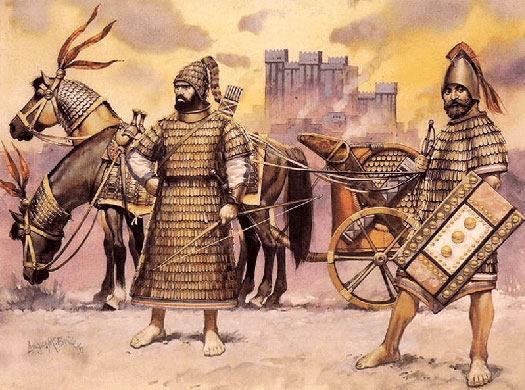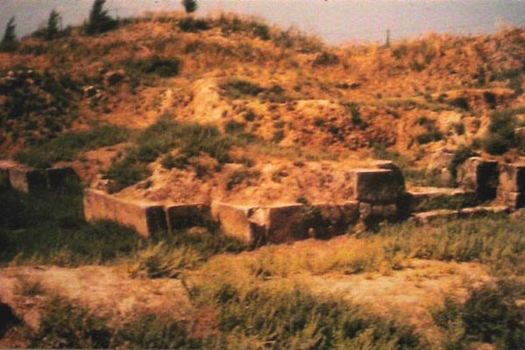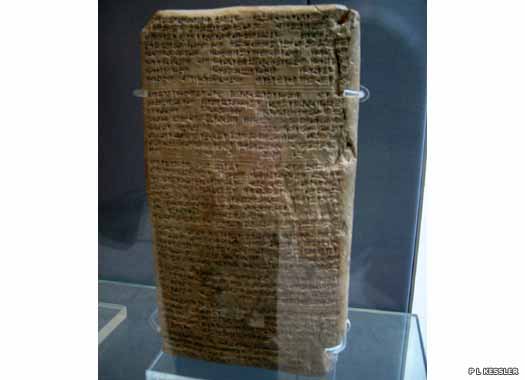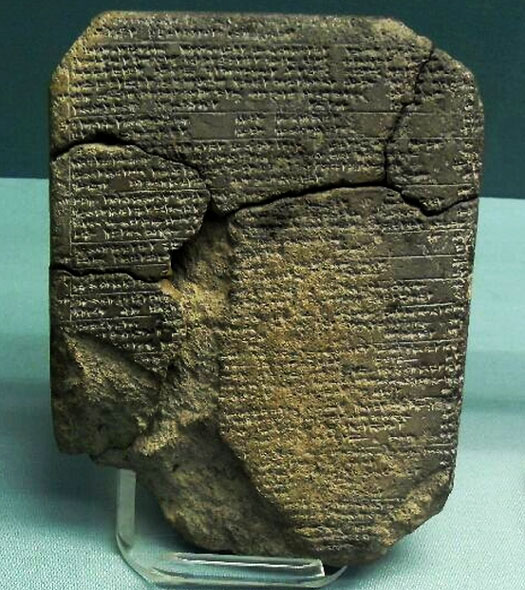
| MITANNI Hurrian
Empire of Mitanni (Naharina / Hanigalbat) :
Centred on eastern Syria and northern Mesopotamia, geographically-speaking the Hurrians were situated amongst much better attested ancient peoples. The Assyrians were immediately to the east. To the north-west there were the Hittites, to the west and south-west were Syria, Canaan and Egypt, and to the south lay Babylonia. The middle of the second millennium was a critical time in the history of the region. An 'age of internationalism' flourished with large states reaching out to each other for the first time. There were intensive contacts between rulers, and the Hurrians played a significant role in transmitting both goods and ideas back and forth among the great empires of the area and out into the Mediterranean world.
Although the Hurrians became a dominant political force in their own right in the region of Urkesh and, separately, in Arrapha, their rise to greatness seems to have been triggered around four hundred years after their arrival by a new influx of settlers. Around 1600 BC an Indo-Iranian people called the Mitanni established themselves amidst the Hurrians as a warrior class. This warrior class seems to have been an early part of what became a mass migration of Indo-Iranian peoples into Iran, South Asia, and northern India.
Although a division is usually applied between those who remained to the north of the Hindu Kush (Indo-Iranians) and to the south (Indo-Aryans), the Mitanni seem to exhibit marked Indo-Aryan cultural traits, putting them at the very forefront of Indo-Aryan expansion and, highly unusually, not into India but into what is now Iran and beyond, well before the Indo-Iranian Mannaeans, Medians, and Parsua reached the region. The main reason for classing the Mitanni as Indo-Aryans is the fact that the names for their gods seem to exhibit more of an Indo-Aryan inclination than an Indo-Iranian one. Thieme's 1960 analysis of gods' names and functions that were known from the Mitanni treaties of the fourteenth century BC showed that the chain of gods that were invoked to protect the treaties corresponded to those that were known from the Vedic hymns (Mitrá-Varun, Indra-... Ashvin, and Nasatya), and cannot be Indo-Iranian (the reconstruction of which would give a quite different chain of names: *Mitrá-, *Asur, and *Vrtraghnas).
The two peoples - Hurrians and Mitanni - quickly coalesced into a feudal state and, during the dark age of 1600-1500 BC, this came to dominate its neighbours. Its capital of Washukkanni has never been positively identified by modern scholars, but Tell al-Fakhariyeh in modern Syria is the favoured location. The pharaohs of Egypt corresponded with the Mitanni rulers of the empire, calling it Naharina after the Akkadian word for river, and Syrian musicians at Ugarit performed Hurrian compositions (Assyrians, on the other hand, always referred to it as Hanigalbat). The later Hurrian empire of Mitanni became a world power a little before 1500 BC, but survived for less than three hundred years. By the thirteenth century BC the Hurrians had been blotted out by the Hittites to the west and the Assyrians to the east, and they ceased being significant participants in international affairs. Little of their own writings survived, other than a treaty with the Hittites.
Dates here should be taken as approximate as they are calculated against the more concrete dates known for other kingdoms. No king lists exist for Mitanni and its early history is a mystery. Its people have been linked by some scholars to the 'Qutils', a group that has also been linked to the Gutians of the previous millennia, and to the modern-day Kurds.
(Information by Peter Kessler, with additional information from Comments on Indo-Iranians and Tokharians: a response to R Heine-Geldern, Marija Gimbutas (American Anthropologist, 1964.66:893-898), from Mittani Empire and the Question of Absolute Chronology: Some Archaeological Considerations, Mirko Novák (published as part of The Synchronisation of Civilisations in the Eastern Mediterranean in the Second Millennium BC III, Manfred Bietak & Ernst Czerny (Eds), Österreichische Akademie der Wissenschaften Denkschrift Band XXXVII; Wien, 2007), from Aryan Gods in the Mitanni Treaties, Paul Thieme (1960), from Historical Atlas of the Ancient World, 4,000,000 to 500 BC, John Haywood (Barnes & Noble, 2000), from The Ancient Near East, c.3000-330 BC, Amélie Kuhrt (Volumes I & II, Routledge, 2000), from The Penguin Atlas of Ancient History, Colon McEvedy (which misses the period 1600-1300 BC but shows a Mitanni kingdom in 1300-1000 BC, by which time it had certainly disappeared - Penguin Books, 1967, revised 2002), from Cultural Atlas of Mesopotamia and the Ancient Near East, Michael Road (Facts on File, 2000), from Ancient Iraq, Georges Roux (Penguin Books, 1992), from The Hurrians, Gernot Wilhelm (Aris & Philips Warminster 1989), from Naming Names: The 2004 Season of Excavations at Ancient Urkesh, Giorgio & Marilyn Kelly-Buccellati (via
External Link: the Institute of Archaeology, UCLA), and from A History of the Ancient Near East c.3000-323 BC, Marc van der Mieroop (Blackwell Publishing, 2004, 2007).)
c.1595 BC :
The Hittite destruction of Alep and its sack of Babylon allows other states to emerge, most notably the Hurrian empire of Mitanni, where the warring Hurrian tribes and city states become united under one dynasty. Many cities which have previously formed small states of their own are incorporated into the new empire, including Andarig, Apum, Carchemish, Nawar, Qatna, Qattara, Razama, Tuttul, and Urkesh. Nothing is known about the earliest Mitanni kings.
The Hittites were dominant in central Anatolia between 1650-1595 BC, but were opposed in northern Mesopotamia by the Hurrian empire which was controlled by the Mitanni c.1530 - 1500 BC :
Parattarna I : Probably same as Barattarna, below.
c.1500 - 1490 BC :
Kirta : Near legendary figure who shaped the empire.
c.1490 - 1470 BC :
Shuttarna / Šuttarna I : Son. Or ruled c.1560 BC?
1478 BC :
Egypt
begins to move into Syria, on Mitanni's southern border, reaching
the Euphrates, building ships, and ravaging the banks all the way
from Carchemish to Emar, towns that belong to Mitanni. Ugarit is
taken, but the Egyptians are unable to gain control of the Syrian
interior. Mitanni (known to Egypt as Naharina) apparently
controls Ishuwa during Shuttarna's reign.
c.1475 - 1392 BC :
The Hurrians annexe the Adasi Assyrians following their breaking of their vassalage to Babylon and enjoying several generations of independence. Now the son of the last independent Adasi king is placed on the Assyrian throne under Mitanni vassalage.
c.1470 - 1450 BC :
Barattarna / Baratama
c.1765 - 1760 BC :
Parshatatar : Named on a seal. May be the same king as Barattarna.
c.1470 - 1450 BC :
Barattarna (or Parattarna according to a seal later to be issued by his son which is sent to the king of Arrapha) expands the kingdom westwards to encompass Alep (which they call Halab). There is a popular rebellion within Alep that may be encouraged or orchestrated by Mitanni so that it can secure overlordship. If so, it succeeds when the ruler of Alep, Ili Illima, is murdered and his son is forced to flee. Mitanni also secures Idrimi of Alalakh as a vassal while, to the west, it conquers the state of Kizzuwatna.
Mitanni warriors are shown here dressed in a typical northern Mesopotamian costume which they most likely picked up following their arrival in the region in the 1600s BC 1453 BC :
Tuthmosis III of Egypt defeats Mitanni at the Battle of Megiddo, weakening the empire. The state of Amurru and several other Mitanni subjects in southern Syria are lost. However, Arrapha in the east and Terqa in the south become vassal states by about 1450 BC, and Mitanni becomes involved in the Hittite succession war at around the same time.
c.1440 - 1410 BC :
Saushtatar / Saustatar : Son. Contemporary of Niqmepuh of Alakhtum.
c.1430 BC :
Ishuwa
is defeated by the Hittite king, Tudhaliya II (I), and then sides
with Mitanni, probably for protection against their more aggressive
western neighbour. Tudhaliya is unable to take Ishuwa, revealing
the limits of Hittite power in this period, so he successfully attacks
Kizzuwatna instead. Whichever side is responsible for the outbreak
of hostilities, the Ishuwans respond by becoming more hostile to
the Hittites in subsequent years as Mitanni to the south seeks a
strong alliance with Ishuwa against their common enemy.
1420 BC :
The empire stretches from the Mediterranean (including Alalakh in northern Syria), all the way to the northern Zagros Mountains (including Nuzi, Kurrukhanni, and Arrapha (roughly corresponding to modern Kurdistan), and into western Iran). The northern boundary dividing Mitanni from the Hittites and the other Hurrian states is never fixed, with Kizzuwatna and Ishuwa being used as buffer states between the two. The latter now becomes a vassal of Mitanni after it is attacked by the Hittites. Also, friendly relations are finally established between Tuthmose IV of Egypt and Artatama I soon after this date.
This view of part of Alalakh's present-day excavated remnants shows the Level VII (Middle Bronze Age) city gate and the entrance into one of the guard chambers, all of which would have been destroyed by the Hittite attack of about 1650-1620 BC, after which Mitanni eventually gained control c.1415 BC :
Saushtatar reduces Assyria and humiliates its inhabitants by sending the doors of the famous temple of Ashur back to Washukkanni. Records of Assyrian rulers after this point become confused.
Parrattarna II : It is uncertain if this king existed.
c.1410 - 1400 BC :
Artatama I : Married his daughter to Pharaoh Thutmose IV.
c.1400 BC :
Sunassura of Kizzuwatna is a contemporary of the Hittite king, Tudhaliya II (I), and then his successor, Arnuwanda I. Allegiance is shifted back to the Hittites in this period, as the state becomes a battleground between them and Mitanni, but Arnuwanda overruns and conquers the state, making Sunassura a vassal. At about the same time, further to the south, an apparent vassal king is allowed to rule in Qatna.
c.1400 - 1385 BC :
Shuttarna / Šuttarna II : Married his daughter to Pharaoh Amenhotep III.
c.1392 BC :
The Hittites in Anatolia wrest control of the Assyrians from Mitanni. The period of Mitanni-dominated Assyrian vassal kings ends as the Assyrians gain more freedom under their new overlords. The Hittites also appear to annexe the Mitanni capital itself to their vassal state of Kizzuwatna, if only briefly.
c.1385 - 1380 BC :
Artashumara : Son. Murdered by Uthi and replaced by his younger brother.
c.1380 BC :
Artashumara is murdered by Uthi, and the latter places his young brother, Tushratta, on the throne, with himself acting as regent. Tushratta's brother, Artatama II, sets up a rival kingship in the east of the state. He initially receives support from the Hittites who are no doubt only too delighted to be able to encourage internecine feuding within the empire.
c.1380 - 1350 BC :
Tushratta / Tusratta : Brother. Assassinated.
c.1380 - 1370? BC :
Uthi / UD-hi : Regent and murderer of Artashumara. Executed.
Tushratta only manages to re-establish friendly relations with Egypt when he has Uthi and all his supporters executed. Later he marries his daughter to Pharaoh Amenhotep III, and the two kings (and later Amenhotep's son, Amenhotep IV) conduct a long and detailed correspondence, mostly on commerce, Tushratta's desire for gold (to fight his civil war), and marriage. Tushratta is considered by some - extremely controversially - to be a proto-Croatian.
The cuneiform tablet inscribed with a letter from Tushratta, king of Mitanni, to Pharaoh Amenhotep III, covers various subjects such as the killing of the murderers of the Mitanni king's brother and a fight against the Hittites c.1380? - ? BC :
Artatama II : Brother of Tushratta. Rival claimant. Based in the east.
c.1375 BC :
The Kaskans suffer the loss of their grain to locusts so, in search of food, they join up with Hayasa-Azzi, Ishuwa, and the Lukka, as well as other Hittite enemies. The devastation to the grain crops may also have been suffered by others, making it not only easy to get them all to unite but highly necessary, and the Hittites may be taken by surprise by the sheer forcefulness of the attack.
It is possible that Ishuwa receives support, or at least encouragement, from Tushratta of Mitanni to join the attack upon the Hittites. It would certainly be in Tushratta's interest to do anything he can to weaken potential Hittite support for his brother and rival. Recent Hittite resurgence indeed does suffer a knock when their fort of Masat is burned down, but then the capital, Hattusa, is itself attacked and burned. This disaster personally weakens the position of the Hittite king but seemingly does little to set back the Hittites themselves.
c.1360s BC :
To support the idea that the Hittites are little-affected by the 'grain war' of about 1375 BC, the Hurrians are devastatingly defeated by the Hittites in a shock reversal of fortune, also losing territory in Syria to them and, now a Hittite vassal, the kingdom rapidly declines. A confused period develops with rival claimants and short-lived rulers hastening the process of decline.
c.1350 BC :
Tushratta is assassinated (possibly by Shuttarna III), sparking a fresh dynastic struggle between his now exiled son and his nephew. The important administrative centre of Nuzi on the edge of the kingdom is lost to the resurgent Assyrians, and it seems likely that Arrapha is lost at the same time.
c.1350 BC :
Shuttarna / Šuttarna III : Son. Gained overall control.
Gaining overall control in Mitanni, Shuttarna shifts his allegiance to Assyria. The Hittite king, Suppiluliuma, is enraged by this and decides to support the exiled Kili-Teshub, son of Tushratta. He provides Kili-Teshub with troops and together they defeat Shuttarna. Kili-Teshub is placed on the throne of what remains of Mitanni (the west of the state) under the name Shattiwaza, is married off to one of the Hittite king's daughters, and becomes a vassal.
The 'Aleppo Treaty' was drawn up on a cuneiform tablet between Mursili I of the Hittites and Talmi-Sharruma of Alep in the mid-fourteenth century, reflecting the increasing Hittite influence in the region at the expense of the Mitanni By the 1320s BC, Syria falls under Hittite overlordship while the Assyrians dominate the regions which had previously formed eastern Mitanni. The territory of Ashtata and the city of Carchemish are given to one of Suppiluliuma's sons.
c.1350 - 1320 BC :
Shattiwaza / Mattiwaza / Kili-Teshub : Son of Tushratta. Exiled. Returned as a Hittite vassal.
c.1339 BC :
By now, the Mitanni warrior class has been totally absorbed into the Hurrian populace, leaving little trace of its existence including its Indo-Aryan language. It takes close examination by modern scholars to discover that they are of an Indo-Iranian heritage, and quite probably specifically Indo-Aryan.
c.1320 - 1300 BC :
Shattuara / Šattuara I : Son. Became an Assyrian vassal.
c.1300 - 1270 BC :
The now-independent Assyrians gradually take control of Mitanni (which they have always referred to as Hanigalbat) from a weakening Hittite regime, leaving the native dynasty in place as vassals. The remnants of the Mitanni state regularly resist, seeking help from the Hittites and the newly arriving Aramaeans. Wasashatta himself resists and his forces and capital city are crushed. He is deported to Assur along with much of the royal family.
c.1300 - 1280 BC :
Wasashatta / Wasašatta : Son. Captured and deported to Assur.
c.1280 - 1270 BC :
Shattuara / Šattuara II : Son or nephew. May be the same as Shattuara I.
c.1270 BC :
Possibly one of the few native nobles left in Hanigalbat, Shattuara rebels against Assyrian overlordship, but his forces are crushed by Shalmaneser I. Hanigalbat (eastern Mitanni) falls totally under Assyrian control and part of the population is deported to serve as cheap labour. An Assyrian grand vizier is brought in to control Hangilbat directly.
c.1270 - 1240 BC :
Ili-ipada : Assyrian grand vizier who served as king of Hanigalbat.
c.1240? BC :
A second rebellion against Assyrian overlordship in the northern and western areas of Hanigalbat leads Tukulti-Ninurta I to annexe the entirety of northern Syria east of the Euphrates.
c.1200 BC :
The international system has recently been creaking under the strain of increasing waves of peasants and the poor leaving the cities and abandoning crops. Around the end of this century the entire region is also hit by drought and the loss of surviving crops. Food supplies dwindle and raids by people who have banded together greatly increases until, by about 1200 BC, this flood has turned into a tidal wave.
Centralised administration disappears completely - the Hittite empire is looted and destroyed by various surrounding peoples, including the Kaskans and the Sea Peoples (and perhaps even selectively by its own populace). The subjugated Hurrians are absorbed into Assyrian and later cultures and leave few traces of their own culture or language behind them, although they can possibly be associated with the later Armenians and Kurds.
To know more about Mitanni and various important links Click here.
Source :
https://www.historyfiles.co.uk/ |




